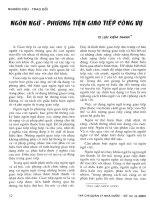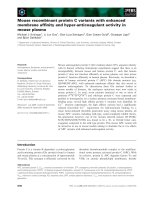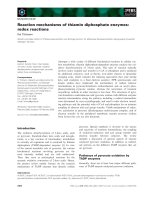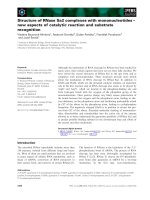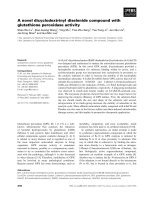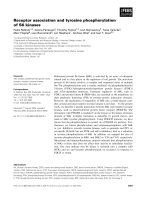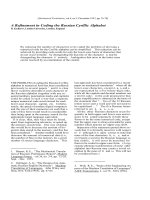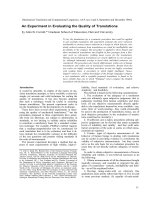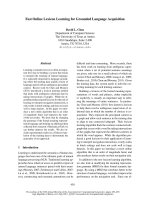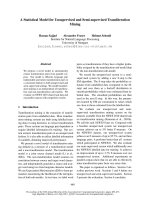Tài liệu Báo cáo khoa học: "Guiding Statistical Word Alignment Models With Prior Knowledge" pdf
Bạn đang xem bản rút gọn của tài liệu. Xem và tải ngay bản đầy đủ của tài liệu tại đây (239.44 KB, 8 trang )
Proceedings of the 45th Annual Meeting of the Association of Computational Linguistics, pages 1–8,
Prague, Czech Republic, June 2007.
c
2007 Association for Computational Linguistics
Guiding Statistical Word Alignment Models With Prior Knowledge
Yonggang Deng and Yuqing Gao
IBM T. J. Watson Research Center
Yorktown Heights, NY 10598
{ydeng,yuqing}@us.ibm.com
Abstract
We present a general framework to incor-
porate prior knowledge such as heuristics
or linguistic features in statistical generative
word alignment models. Prior knowledge
plays a role of probabilistic soft constraints
between bilingual word pairs that shall be
used to guide word alignment model train-
ing. We investigate knowledge that can be
derived automatically from entropy princi-
ple and bilingual latent semantic analysis
and show how they can be applied to im-
prove translation performance.
1 Introduction
Statistical word alignment models learn word as-
sociations between parallel sentences from statis-
tics. Most models are trained from corpora in an
unsupervised manner whose success is heavily de-
pendent on the quality and quantity of the training
data. It has been shown that human knowledge,
in the form of a small amount of manually anno-
tated parallel data to be used to seed or guide model
training, can significantly improve word alignment
F-measure and translation performance (Ittycheriah
and Roukos, 2005; Fraser and Marcu, 2006).
As formulated in the competitive linking algo-
rithm (Melamed, 2000), the problem of word align-
ment can be regarded as a process of word link-
age disambiguation, that is, choosing correct asso-
ciations among all competing hypothesis. The more
reasonable constraints are imposed on this process,
the easier the task would become. For instance, the
most relaxed IBM Model-1, which assumes that any
source word can be generated by any target word
equally regardless of distance, can be improved by
demanding a Markov process of alignments as in
HMM-based models (Vogel et al., 1996), or imple-
menting a distribution of number of target words
linked to a source word as in IBM fertility-based
models (Brown et al., 1993).
Following the path, we shall put more constraints
on word alignment models and investigate ways of
implementing them in a statistical framework. We
have seen examples showing that names tend to
align to names and function words are likely to be
linked to function words. These observations are
independent of language and can be understood by
common sense. Moreover, there are other linguis-
tically motivated constraints. For instance, words
aligned to each other presumably are semantically
consistent; and likely to be, they are syntactically
agreeable. In these paper, we shall exploit some of
these constraints in building better word alignments
in the application of statistical machine translation.
We propose a simple framework that can inte-
grate prior knowledge into statistical word align-
ment model training. In the framework, prior knowl-
edge serves as probabilistic soft constraints that will
guide word alignment model training. We present
two types of constraints that are derived in an un-
supervised way: one is based on the entropy prin-
ciple, the other comes from bilingual latent seman-
tic analysis. We investigate their impact on word
alignments and show their effectiveness in improv-
ing translation performance.
1
2 Constrained Word Alignment Models
The framework that we propose to incorporate sta-
tistical constraints into word alignment models is
generic. It can be applied to complicated models
such IBM Model-4 (Brown et al., 1993). We shall
take HMM-based word alignment model (Vogel et
al., 1996) as an example and follow the notation of
(Brown et al., 1993). Let e = e
l
1
represent a source
string and f = f
m
1
a target string. The random vari-
able a = a
m
1
specifies the indices of source words
that target words are aligned to.
In an HMM-based word alignment model, source
words are treated as Markov states while target
words are observations that are generated when
jumping to states:
P (a, f|e) =
m
j=1
P (a
j
|a
j−1
, e)t(f
j
|e
a
j
)
Notice that a target word f is generated from a
source state e by a simple lookup of the translation
table, a.k.a., t-table t(f |e), as depicted in (A) of Fig-
ure 1. To incorporate prior knowledge or impose
constraints, we introduce two nodes E and F repre-
senting the hidden tags of the source word e and the
target word f respectively, and organize the depen-
dency structure as in (B) of Figure 1. Given this gen-
erative procedure, f will also depend on its tag F,
which is determined probabilistically by the source
tag E. The dependency from E to F functions as a
soft constraint showing how the two hidden tags are
agreeable to each other. Mathematically, the condi-
tional distribution follows:
P (f|e) =
E,F
P (f, E, F|e)
=
E,F
P (E|e)P (F |E)P (f|e, F )
= t(f|e) · Con(f, e), (1)
where
Con(f, e) =
E,F
P (E|e)P (F |E)P (F |f)/P(F) (2)
is the soft weight attached to the t-table entry. It con-
siders all possible hidden tags of e and f and serves
as constraint between the link.
f
e
f
e
E
F
A B
Figure 1: A simple table lookup (A) vs. a con-
strained procedure (B) of generating a target word
f from a source word e.
We do not change the value of Con(f, e) during
iterative model training but rather keep it constant as
an indicator of how strong the word pair should be
considered as a candidate. This information is de-
rived before word alignment model training and will
act as soft constraints that need to be respected dur-
ing training and alignments. For a given word pair,
the soft constraint can have different assignment in
different sentence pairs since the word tags can be
context dependent.
To understand why we take the “detour” of gen-
erating a target word rather than directly from a t-
table, consider the hidden tag as binary value in-
dicating being a name or not. Without these con-
straints, t-table entries for names with low frequency
tend to be flat and word alignments can be chosen
randomly without sufficient statistics or strong lexi-
cal preference under maximum likelihood criterion.
If we assume that a name is produced by a name
with a high probability but by a non-name with a
low probability, i.e. P(F = E) >> P(F = E),
proper names with low counts then are encouraged
to link to proper names during training; and conse-
quently, conditional probability mass would be more
focused on correct name translations. On the other
hand, names are discouraged to produce non-names.
This will potentially avoid incorrect word associa-
tions. We are able to apply this type of constraint
since usually there are many monolingual resources
available to build a high performance probabilistic
name tagger. The example suggests that putting rea-
sonable constraints learned from monolingual analy-
sis can alleviate data spareness problem in bilingual
applications.
The weights Con(f, e) are the prior knowledge
that shall be assigned with care but respected dur-
ing training. The baseline is to set all these weights
2
to 1, which is equivalent to placing no prior knowl-
edge on model training. The introduction of these
weights does not complicate parameter estimation
procedure. Whenever a source word e is hypoth-
esized to generate a target word f, the translation
probability t(f|e) should be weighted by Con(f, e).
We point out that the constraints between f and e
through their hidden tags are in probabilities. There
are no hard decisions made before training. A strong
preference between two words can be expressed by
assigning corresponding weights close to 1. This
will affect the final alignment model.
Depending on the hidden tags, there are many re-
alizations of reasonable constraints that can be put
beforehand. They can be semantic classes, syntactic
annotations, or as simple as whether being a function
word or content word. Moreover, the source side and
the target side do not have to share the same set of
tags. The framework is also flexible to support mul-
tiple types of constraints that can be implemented in
parallel or cascaded sequence. Moreover, the con-
straints between words can be dependent on context
within parallel sentences. Next, we will describe
two types of constraints that we proposed. Both of
them are derived from data in an unsupervised way.
2.1 Entropy Principle
It is assumed that generally speaking, a source func-
tion word generates a target function word with a
higher probability than generating a target content
word; similar assumption applies to a source con-
tent word as well. We capture this type of constraint
by defining the hidden tag E and F as binary labels
indicating being a content word or not. Based on
the assumption, we design probabilistic relationship
between the two hidden tags as:
P (E = F ) = 1 − P (E = F ) = α,
where α is a scalar whose value is close to 1, say
0.9. The bigger α is, the tighter constraint we put on
word pairs to be connected requiring the same type
of label.
To determine the probability of a word being
a function word, we apply the entropy principle.
A function word, say “of”,“in” or “have”, appears
more frequently than a content word, say “journal”
or “chemistry”, in a document or sentence. We will
approximate the probability of a word as a function
word with the relative uncertainty of its being ob-
served in a sentence.
More specifically, suppose we have N parallel
sentences in the training corpus. For each word w
i
1
,
let c
ij
be the number of word w
i
observed in the j-th
sentence pair, and let c
i
be the total number of oc-
currences of w
i
in the corpus. We define the relative
entropy of word w
i
as
w
i
= −
1
log N
N
j=1
c
ij
c
i
log
c
ij
c
i
.
With the entropy of a word, the likelihood of word
w being tagged as a function word is approximated
with w
(1)
=
w
and being tagged as a content word
with w
(0)
= 1 −
w
.
We ignore the denominator in Equ. (2) and find
the constraint under the entropy principle:
Con(f, e) = α(e
(0)
f
(0)
+ e
(1)
f
(1)
) +
(1 − α)(e
(1)
f
(0)
+ e
(0)
f
(1)
).
As can be seen, the connection between two
words is simulated with a binary symmetric chan-
nel. An example distribution of the constraint func-
tion is illustrated in Figure 2. A high value of α
encourages connecting word pairs with compara-
ble entropy; When α = 0.5, Con(f, e) is constant
which corresponds to applying no prior constraint;
When α is close to 0, the function plays opposite
role on word alignment training where a high fre-
quency word is pushed to associate with a low fre-
quency word.
2.2 Bilingual Latent Semantic Analysis
Latent Semantic Analysis (LSA) is a theory and
method for extracting and representing the meaning
of words by statistically analyzing word contextual
usages in a collection of text. It provides a method
by which to calculate the similarity of meaning of
given words and documents. LSA has been success-
fully applied to information retrieval (Deerwester
et al., 1990), statistical langauge modeling (Belle-
garda, 2000) and etc.
1
We prefix ‘E ’ to source words and ‘F ’ to target words
to distinguish words that have the same spelling but are from
different languages.
3
0
0.2
0.4
0.6
0.8
1
0
0.2
0.4
0.6
0.8
1
0
0.1
0.2
0.3
0.4
0.5
0.6
0.7
0.8
0.9
Con(f,e)
alpha=0.9
e
(0)
f
(0)
0
0.2
0.4
0.6
0.8
1
0
0.2
0.4
0.6
0.8
1
0.1
0.2
0.3
0.4
0.5
0.6
0.7
0.8
0.9
Con(f,e)
alpha=0.1
e
(0)
f
(0)
Figure 2: Distribution of the constraint function
based on entropy principle when α = 0.9 on the
left and α = 0.1 on the right.
We explore LSA techniques in bilingual environ-
ment to derive semantic constraints as prior knowl-
edge for guiding a word alignment model train-
ing. The idea is to find semantic representation of
source words and target words in the so-called low-
dimensional LSA-space, and then to use their sim-
ilarities to quantitatively establish semantic consis-
tencies. We propose two different approaches.
2.2.1 A Simple Bag-of-word Model
One method we investigate is a simple bag-of-
word model as in monolingual LSA. We treat each
sentence pair as a document and do not distin-
guish source words and target words as if they
are terms generated from the same vocabulary. A
sparse matrix W characterizing word-document co-
occurrence is constructed. Following the notation in
section 2.1, the ij-th entry of the matrix W is de-
fined as in (Bellegarda, 2000)
W
ij
= (1 −
w
i
)
c
ij
c
j
,
where c
j
is the total number of words in the j-th
sentence pair. This construction considers the im-
portance of words globally (corpus wide) and locally
(within sentence pairs). Alternative constructions of
the matrix are possible using raw counts or TF-IDF
(Deerwester et al., 1990).
W is a M × N sparse matrix, where M is the
size of vocabulary including both source and target
words. To obtain a compact representation, singular
value decomposition (SVD) is employed (cf. Berry
et al (1993)) to yield W ≈
ˆ
W = U × S × V
T
as Figure 3 shows, where, for some order R
min(M, N) of the decomposition, U is a M ×R left
singular matrix with rows u
i
, i = 1, · · · , M, S is a
R×R diagonal matrix of singular values s
1
≥ s
2
≥
. . . ≥ s
R
0, and V is N×R a right singular ma-
trix with rows v
j
, j = 1, · · · , N. For each i, the
scaled R-vector u
i
S may be viewed as representing
w
i
, the i-th word in the vocabulary, and similarly the
scaled R-vector v
j
S as representing d
j
, j-th docu-
ment in the corpus. Note that the u
i
S’s and v
j
S’s
both belong to IR
R
, the so-called LSA-space. All
target and source words are projected into the same
LSA-space too.
NM × R
M
×
RR×
NR×
R orthonormal vectorsDocuments
1w
Mw
Words
W
US
T
V
1
d
N
d
R orthonormal vectors
Figure 3: SVD of the Sparse Matrix W .
As Equ. (2) suggested, to induce semantic con-
straints in a straightforward way, one would proceed
as follows: firstly, perform word semantic cluster-
ing with, say, their compact representations in the
LSA-space; secondly, construct cluster generating
dependencies by specifying the conditional distribu-
tion of P (F |E); and finally, for each word pair, in-
duce the semantic constraint by considering all pos-
sible semantic labeling schemes. We approximate
this long process with simply finding word similar-
ities defined by their cosine distance in the low di-
mension space:
Con(f, e) =
1
2
(cos(u
f
S, u
e
S) + 1) (3)
The linear mapping above is introduced to avoid
negative constraints and to set the maximum con-
straint value as 1.
In building word alignment models, a special
“NULL” word is usually introduced to address tar-
get words that align to no source words. Since this
physically non-existing word is not in the vocabu-
lary of the bilingual LSA, we use the centroid of all
source words as its vector representation in the LSA-
space. The semantic constraints between “NULL”
and any target words can be derived in the same way.
However, this is chosen for mostly computational
4
convenience, and is not the only way to address the
empty word issue.
2.2.2 Utilizing Word Alignment Statistics
While the simple bag-of-word model puts all
source words and target words as rows in the ma-
trix, another method of deriving semantic constraint
constructs the sparse matrix by taking source words
as rows and target words as columns and uses statis-
tics from word alignment training to form word pair
co-occurrence association.
More specifically, we regard each target word f as
a “document” and each source word e as a “term”.
The number of occurrences of the source word e in
the document f is defined as the expected number
of times that f generates e in the parallel corpus
under the word alignment model. This method re-
quires training the baseline word alignment model
in another direction by taking fs as source words
and es as target words, which is often done for
symmetric alignments, and then dumping out the
soft counts when model converges. We threshold
the minimum word-to-word translation probability
to remove word pairs that have low co-occurrence
counts.
Following the similarity induced semantic con-
straints in section 2.2.1, we need to find the distance
between a term and a document. Let v
f
be the pro-
jection of the document representing the target word
f and u
e
the projection of the term representing the
source word e after performing SVD on the sparse
matrix, we calculate the similarity between (f, e)
and then find their semantic constraint to be
Con(f, e) =
1
2
(cos(v
f
S
1/2
, u
e
S
1/2
) + 1) (4)
Unlike the method in section 2.2.1, there is no
empty word issue here since we do have statistics
of the “NULL” word as a source word generating e
words and therefore there is a “document” assigned
to it.
3 Experimental Results
We test our framework on the task of large vocab-
ulary translation from dialectical (Iraqi) Arabic ut-
terances into English. The task covers multiple do-
mains including travel, emergency medical diagno-
sis, defense-oriented force protection, security and
etc. To avoid impacts of speech recognition errors,
we only report experiments from text to text transla-
tion.
The training corpus consists of 390K sentence
pairs, with total 2.43M Arabic words and 3.38M En-
glish words. These sentences are in typical spoken
transcription form, i.e., spelling errors, disfluencies,
such as word or phrase repetition, and ungrammat-
ical utterances are commonly observed. Arabic ut-
terance length ranges from 3 to 70 words with the
average of 6 words.
There are 25K entries in the English vocabulary
and 90K in Arabic side. Data sparseness severely
challenges word alignment model and consequently
automatic phrase translation induction. There are
42K singletons in Arabic vocabulary, and 14K Ara-
bic words with occurrence of twice each in the cor-
pus. Since Arabic is a morphologically rich lan-
guage where affixes are attached to stem words to
indicate gender, tense, case and etc, in order to re-
duce vocabulary size and address out-of-vocabulary
words, we split Arabic words into affix and root ac-
cording to a rule-based segmentation scheme (Xiang
et al., 2006) with the help from the Buckwalter ana-
lyzer (LDC, 2002) output. This reduces the size of
Arabic vocabulary to 52K.
Our test data consists of 1294 sentence pairs.
They are split into two parts: half of them is used as
the development set, on which training parameters
and decoding feature weights are tuned, the other
half is for test.
3.1 Training and Translation Setup
Starting from the collection of parallel training sen-
tences, we train word alignment models in two trans-
lation directions, from English to Iraqi Arabic and
from Iraqi Arabic to English, and derive two sets
of Viterbi alignments. By combining word align-
ments in two directions using heuristics (Och and
Ney, 2003), a single set of static word alignments
is then formed. All phrase pairs which respect to
the word alignment boundary constraint are iden-
tified and pooled to build phrase translation tables
with the Maximum Likelihood criterion. We prune
phrase translation entries by their probabilities. The
maximum number of tokens in Arabic phrases is set
to 5 for all conditions.
Our decoder is a phrase-based multi-stack imple-
5
mentation of the log-linear model similar to Pharaoh
(Koehn et al., 2003). Like other log-linear model
based decoders, active features in our translation en-
gine include translation models in two directions,
lexicon weights in two directions, language model,
distortion model, and sentence length penalty. These
feature weights are tuned on the dev set to achieve
optimal translation performance using downhill sim-
plex method (Och and Ney, 2002). The language
model is a statistical trigram model estimated with
Modified Kneser-Ney smoothing (Chen and Good-
man, 1996) using all English sentences in the paral-
lel training data.
We measure translation performance by the
BLEU score (Papineni et al., 2002) and Translation
Error Rate (TER) (Snover et al., 2006) with one ref-
erence for each hypothesis. Word alignment mod-
els trained with different constraints are compared
to show their effects on the resulting phrase transla-
tion tables and the final translation performance.
3.2 Translation Results
Our baseline word alignment model is the word-to-
word Hidden Markov Model (Vogel et al., 1996).
Basic models in two translation directions are
trained simultaneously where statistics of two direc-
tions are shared to learn symmetric translation lexi-
con and word alignments with high precision moti-
vated by (Zens et al., 2004) and (Liang et al., 2006).
The baseline translation results (BLEU and TER) on
the dev and test set are presented in the line “HMM”
of Table 1. We also compare with results of IBM
Model-4 word alignments implemented in GIZA++
toolkit (Och and Ney, 2003).
We study and compare two types of constraint and
see how they affect word alignments and translation
output. One is based on the entropy principle as de-
scribed in Section 2.1, where α is set to 0.9; The
other is based on bilingual latent semantic analysis.
For the simple bag-of-word bilingual LSA as de-
scribed in Section 2.2.1, after SVD on the sparse ma-
trix using the toolkit SVDPACK (Berry et al., 1993),
all source and target words are projected into a low-
dimensional (R = 88) LSA-space. Word pair se-
mantic constrains are calculated based on their sim-
ilarity as in Equ. 3 before word alignment training.
Like the baseline, we perform 6 iterations of IBM
Model-1 training and then 4 iteration of HMM train-
ing. The semantic constraints are used to guide word
alignment model training for each iteration. The
BLEU score and TER with this constraint are shown
in the line “BiLSA-1” of Table 1.
To exploit word alignment statistics in bilingual
LSA as described in Section 2.2.2, we dump out the
statistics of the baseline word alignment model and
use them to construct the sparse matrix. We find
low-dimensional representation (R = 67) of English
words and Arabic words and use their similarity to
establish semantic constraints as in Equ. 4. The
training procedure is the same as the baseline and
“BiLSA-1”. The translation results with these word
alignments are shown as “BiLSA-2” in Table 1.
As Table 1 shows, when the entropy based con-
straints are applied, BLEU score improves 0.5 point
on the test set. Clearly, when bilingual LSA con-
straints are applied, translation performance can be
improved up to 1.6 BLEU points. We also observe
that TER can drop 2.1 points with the “BiLSA-1”
constraint.
While “BiLSA-1” constraint performs better on
the test set, “BiLSA-2” constraint achieves slightly
higher BLEU score on the dev set. We then
try a simple combination of these two types
of constraints, that is the geometric mean of
Con
BiLSA−1
(f, e) and Con
BiLSA−2
(f, e), and find
out that BLEU score can be improved a little bit fur-
ther on both sets as the line “Mix” shows.
We notice that the relatively simpler HMM model
can perform comparable or better than the sophis-
ticated Model-4 when proper constraints are active
in guiding word alignment model training. We also
try to put constraints in Model-4. As the Equation
1 implies, when a word-to-word generative proba-
bility is needed, one should multiply corresponding
lexicon entry in the t-table with the word pair con-
straint. We simply modify the GIZA++ toolkit (Och
and Ney, 2003) by always weighting lexicon proba-
bilities with soft constraints during iterative model
training, and obtain 0.7% TER reduction on both
sets and 0.4% BLEU improvement on the test set.
3.3 Analysis
To understand how prior knowledge encoded as soft
constraints plays a role in guiding word alignment
training, we compare statistics of different word
alignment models. We find that our baseline HMM
6
Table 1: Translation Results with different word
alignments.
BLEU TER
Alignments
dev test dev test
Model-4 0.310 0.296 0.528 0.530
+Mix 0.306 0.300 0.521 0.523
HMM 0.289 0.288 0.543 0.542
+Entropy 0.289 0.293 0.534 0.536
+BiLSA-1 0.294 0.300 0.531 0.521
+BiLSA-2 0.298 0.292 0.530 0.528
+Mix 0.302 0.304 0.532 0.524
generates 2.6% less number of total word links than
that of Model-4. Part of the reason is that mod-
els of two directions in the baseline are trained si-
multaneously. The requirement of bi-directional ev-
idence places a certain constraint on word align-
ments. When “BiLSA-1” constraints are applied in
the baseline model, 2.7% less number of total word
links are hypothesized, and consequently, less num-
ber of Arabic n-gram translations in the final phrase
translation table are induced. The observation sug-
gests that the constraints improve word alignment
precision and accuracy of phrase translation tables
as well.
bAl_ mrM mAl _tk
in your esophagus
HMM
bAl_ mrM mAl _tk
in your esophagus
+BiLSA-1
bAl_ mrM mAl _tk
in your esophagus
Model-4
(in) (esophagus) gloss (ownership) (yours)
Figure 4: An example of word alignments under dif-
ferent models
Figure 4 shows example word alignments of a par-
tial sentence pair. The complete English sentence is
“have you ever had like any reflux diseases in your
esophagus”. We notice that the Arabic word “mrM”
(means esophagus) appears only once in the corpus.
Some of the word pair constraints are listed in Ta-
ble 2. The example demos that due to reasonable
constraints placed in word alignment training, the
link to “ tK” is corrected and consequently we have
accurate word translation for the Arabic singleton
Table 2: Word pair constraint values
English e Arabic f Con
BiLSA−1
(f, e)
esophagus mrM 0.6424
mAl 0.1819
tk 0.2897
your mrM 0.6319
mAl 0.4930
tk 0.9672
“mrM”.
4 Related Work
Heuristics based on co-occurrence analysis, such as
point-wise mutual information or Dice coefficients
, have been shown to be indicative for word align-
ments (Zhang and Vogel, 2005; Melamed, 2000).
The framework presented in this paper demonstrates
the possibility of taking heuristics as constraints
guiding statistical generative word alignment model
training. Their effectiveness can be expected espe-
cially when data sparseness is severe.
Discriminative word alignment models, such as
Ittycheriah and Roukos (2005); Moore (2005);
Blunsom and Cohn (2006), have received great
amount of study recently. They have proven that lin-
guistic knowledge is useful in modeling word align-
ments under log-linear distributions as morphologi-
cal, semantic or syntactic features. Our framework
proposes to exploit these features differently by tak-
ing them as soft constraints of translation lexicon un-
der a generative model.
While word alignments can help identifying se-
mantic relations (van der Plas and Tiedemann,
2006), we proceed in the reverse direction. We in-
vestigate the impact of semantic constraints on sta-
tistical word alignment models as prior knowledge.
In (Ma et al., 2004), bilingual semantic maps are
constructed to guide word alignment. The frame-
work we proposed seamlessly integrates derived se-
mantic similarities into a statistical word alignment
model. And we extended monolingual latent seman-
tic analysis in bilingual applications.
Toutanova et al. (200 2) augmented bilingual sen-
tence pairs with part-of-speech tags as linguistic
constraints for HMM-based word alignments. The
constraints between tags are automatically learned
in a parallel generative procedure along with lex-
7
icon. We have introduced hidden tags between a
word pair to specialize their soft constraints, which
serve as prior knowledge that will be used in guiding
word alignment model training. Constraint between
tags are embedded into the word to word generative
process.
5 Conclusions and Future Work
We have presented a simple and effective framework
to incorporate prior knowledge such as heuristics
or linguistic features into statistical generative word
alignment models. Prior knowledge serves as soft
constraints that shall be placed on translation lexi-
con to guide word alignment model training and dis-
ambiguation during Viterbi alignment process. We
studied two types of constraints that can be obtained
automatically from data and showed improved per-
formance (up to 1.6% absolute BLEU increase or
2.1% absolute TER reduction) in translating dialec-
tical Arabic into English. Future work includes im-
plementing the idea in alternative alignment mod-
els and also exploiting prior knowledge derived from
such as manually-aligned data and pre-existing lin-
guistic resources.
Acknowledgement We thank Mohamed Afify for
discussions and the anonymous reviewers for sug-
gestions.
References
J. R. Bellegarda. 2000. Exploiting latent semantic informa-
tion in statistical language modeling. Proc. of the IEEE,
88(8):1279–1296, August.
M. Berry, T. Do, and S. Varadhan. 1993. Svdpackc (version
1.0) user’s guide. Tech. report cs-93-194, University of Ten-
nessee, Knoxville, TN.
P. Blunsom and T. Cohn. 2006. Discriminative word alignment
with conditional random fields. In Proc. of COLING/ACL,
pages 65–72.
P. Brown, S. Della Pietra, V. Della Pietra, and R. Mercer. 1993.
The mathematics of machine translation: Parameter estima-
tion. Computational Linguistics, 19:263–312.
S. F. Chen and J. Goodman. 1996. An empirical study of
smoothing techniques for language modeling. In Proc. of
ACL, pages 310–318.
S. C. Deerwester, S. T. Dumais, T. K. Landauer, G. W. Furnas,
and R. A. Harshman. 1990. Indexing by latent semantic
analysis. Journal of the American Society of Information
Science, 41(6):391–407.
A. Fraser and D. Marcu. 2006. Semi-supervised training for
statistical word alignment. In Proc. of COLING/ACL, pages
769–776.
A. Ittycheriah and S. Roukos. 2005. A maximum entropy word
aligner for arabic-english machine translation. In Proc. of
HLT/EMNLP, pages 89–96.
P. Koehn, F. Och, and D. Marcu. 2003. Statistical phrase-based
translation. In Proc. of HLT-NAACL.
LDC, 2002. Buckwalter Arabic Morphological Analyzer Ver-
sion 1.0. LDC Catalog Number LDC2002L49.
P. Liang, B. Taskar, and D. Klein. 2006. Alignment by agree-
ment. In Proc. of HLT/NAACL, pages 104–111.
Q. Ma, K. Kanzaki, Y. Zhang, M. Murata, and H. Isahara.
2004. Self-organizing semantic maps and its application to
word alignment in japanese-chinese parallel corpora. Neural
Netw., 17(8-9):1241–1253.
I. Dan. Melamed. 2000. Models of translational equivalence
among words. Computational Linguistics, 26(2):221–249.
R. C. Moore. 2005. A discriminative framework for bilingual
word alignment. In Proc. of HLT/EMNLP, pages 81–88.
F. J. Och and H. Ney. 2002. Discriminative training and max-
imum entropy models for statistical machine translation. In
Proc. of ACL, pages 295–302.
F. J. Och and H. Ney. 2003. A systematic comparison of vari-
ous statistical alignment models. Computational Linguistics,
29(1):19–51.
K. Papineni, S. Roukos, T. Ward, and W. Zhu. 2002. Bleu: a
method for automatic evaluation of machine translation. In
Proc. of ACL, pages 311–318.
M. Snover, B. Dorr, R. Schwartz, L. Micciulla, and J. Makhoul.
2006. A study of translation edit rate with targeted human
annotation. In Proc. of AMTA.
K. Toutanova, H. T. Ilhan, and C. Manning. 2002. Extentions
to HMM-based statistical word alignment models. In Proc.
of EMNLP.
Lonneke van der Plas and J
¨
org Tiedemann. 2006. Finding syn-
onyms using automatic word alignment and measures of dis-
tributional similarity. In Proc. of the COLING/ACL 2006
Main Conference Poster Sessions, pages 866–873.
S. Vogel, H. Ney, and C. Tillmann. 1996. HMM based word
alignment in statistical translation. In Proc. of COLING.
B. Xiang, K. Nguyen, L. Nguyen, R. Schwartz, and J. Makhoul.
2006. Morphological decomposition for arabic broadcast
news transcription. In Proc. of ICASSP, pages 1089–1092.
R. Zens, E. Matusov, and H. Ney. 2004. Improved word align-
ment using a symmetric lexicon model. In Proc. of COL-
ING, pages 36–42.
Y. Zhang and S. Vogel. 2005. Competitive grouping in inte-
grated phrase segmentation and alignment model. In Proc.
of the ACL Workshop on Building and Using Parallel Texts,
pages 159–162.
8
